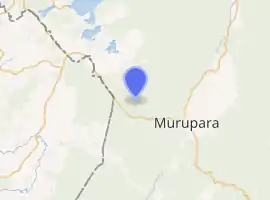Kaingaroa, Bay of Plenty
Kaingaroa is a small town southeast of Rotorua within the Bay of Plenty region of New Zealand's North Island. The town is the headquarters of Kaingaroa Forest.
Kaingaroa | |
|---|---|
Town | |

| |
| Coordinates: 38.408°S 176.565°E | |
| Country | New Zealand |
| Region | Bay of Plenty |
| Territorial authority | Rotorua Lakes |
| Ward | East |
| Population (2018) | |
| • Total | 402 |
| Postcode(s) | 3073 |
Demographics
| Year | Pop. | ±% p.a. |
|---|---|---|
| 2006 | 1,902 | — |
| 2013 | 1,881 | −0.16% |
| 2018 | 1,887 | +0.06% |
| Source: [1] | ||
The statistical area of Kaingaroa-Whakarewarewa, which at 466 square kilometres is much larger than the town, had a population of 1,887 at the 2018 New Zealand census, an increase of 6 people (0.3%) since the 2013 census, and a decrease of 15 people (-0.8%) since the 2006 census. There were 690 households. There were 975 males and 912 females, giving a sex ratio of 1.07 males per female. The median age was 42 years (compared with 37.4 years nationally), with 402 people (21.3%) aged under 15 years, 324 (17.2%) aged 15 to 29, 903 (47.9%) aged 30 to 64, and 261 (13.8%) aged 65 or older.
Ethnicities were 76.5% European/Pākehā, 32.6% Māori, 2.5% Pacific peoples, 2.1% Asian, and 1.3% other ethnicities (totals add to more than 100% since people could identify with multiple ethnicities).
The proportion of people born overseas was 14.5%, compared with 27.1% nationally.
Although some people objected to giving their religion, 56.8% had no religion, 31.2% were Christian, 0.2% were Hindu, 0.2% were Buddhist and 4.3% had other religions.
Of those at least 15 years old, 336 (22.6%) people had a bachelor or higher degree, and 243 (16.4%) people had no formal qualifications. The median income was $37,400, compared with $31,800 nationally. The employment status of those at least 15 was that 771 (51.9%) people were employed full-time, 264 (17.8%) were part-time, and 48 (3.2%) were unemployed.[1]
The population of Kaingaroa town was 402 in the 2018 census, a decrease of 24 from 2013. There were 213 males and 189 females. 88.8% of people identified as Māori, 23.1% as European/Pākehā, 4.5% as Pacific peoples, and 1.5% as Asian.[2]
Marae
Te Huingawaka Marae is local meeting ground for the Tūhoe hapū of Ngāti Kaingaroa and Nga Tipuna O Te Motu.[3] The marae building is a former cookhouse.[4]
In October 2020, the Government committed $461,159 from the Provincial Growth Fund to upgrade the marae, creating 8 jobs.[5]
Education
Kaingaroa Forest School is a co-educational state primary school for Year 1 to 8 students living in the forest area,[6] with a roll of 56 as of March 2020.[7]
References
- "Statistical area 1 dataset for 2018 Census". Statistics New Zealand. March 2020. Kaingaroa-Whakarewarewa (201700). 2018 Census place summary: Kaingaroa-Whakarewarewa
- "Age and sex by ethnic group (grouped total response), for census usually resident population counts, 2006, 2013, and 2018 Censuses (urban rural areas)". Statistics New Zealand. Retrieved 26 December 2020.
- "Kaingaroa Marae". ngaituhoe.com. Tuhoe.
- Hume, Tim (28 August 2009). "Hell in the heartland". stuff.co.nz. Sunday Star Times.
- "Marae Announcements" (Excel). growregions.govt.nz. Provincial Growth Fund. 9 October 2020.
- "Ministry of Education School Profile". educationcounts.govt.nz. Ministry of Education.
- "Education Review Office Report". ero.govt.nz. Education Review Office.